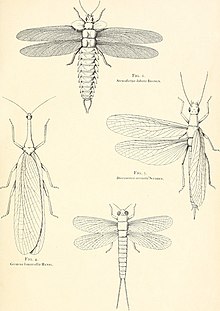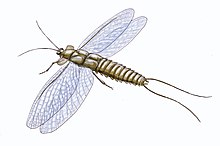Palaeodictyoptera
| Palaeodictyoptera Temporal range: Late Carboniferous to Late Permian
| |
|---|---|

| |
| Illustration of Stenodictya lobata, Gerarus longicollis, Dieconeura arcuata and Eubleptus danielsi | |
| Scientific classification | |
| Kingdom: | Animalia |
| Phylum: | Arthropoda |
| Class: | Insecta |
| Superorder: | †Palaeodictyopteroidea |
| Order: | †Palaeodictyoptera , 1877 |
| Superfamily | |
The Palaeodictyoptera are an extinct order of medium-sized to very large, primitive Palaeozoic paleopterous insects. They are informative about the evolution of wings in insects.
Overview[]

They were characterized by beak-like mouthparts, used to pierce plant tissues for feeding. There is a similarity between their fore- and hindwings, and an additional pair of winglets on the prothorax, in front of the first pair of wings. They are known as "six-winged insects" because of the presence of a pair of wings on each of the thoracic segments.[1][2][3][4] Their winglets provide clues to the origins of the first insect wings.
The mouthparts were elongated, and included sharp piercing stylets, and possibly a sucking pump-like organ. Unlike modern sucking insects, such as the Hemipterans, the mouthparts were held vertically below the head, or projected forwards. They probably used these organs to suck juices from plants, although some may have been ectoparasites, or predators.[5]
Some types attained huge size. For example, Mazothairos had a wingspan of about 55 centimetres (22 in). Another distinctive feature was the presence of unusually long cerci, about twice the length of the abdomen.[5]
The Palaeodictyoptera are a paraphyletic assemblage of basal palaeodictyopteroidean insects, rather than a clade, because they gave rise to other insect orders. They range in time from the Middle Carboniferous (late Serpukhovian or early Bashkirian in age) to the late Permian.
References[]
- ^ Parzer, Harald; Stansbury, Matthew (22 October 2018). "Enriching Undergraduate Entomology Coursework through the Integration of Evolutionary Developmental Biology". The American Biology Teacher. 80 (8): 561–569. doi:10.1525/abt.2018.80.8.561.
- ^ Tomoyasu, Yoshinori; Wheeler, Scott R.; Denell, Robin E. (February 2005). "Ultrabithorax is required for membranous wing identity in the beetle Tribolium castaneum". Nature. 433 (7026): 643–647. Bibcode:2005Natur.433..643T. doi:10.1038/nature03272. PMID 15703749.
- ^ Elias-Neto, Moysés; Belles, Xavier (3 August 2016). "Tergal and pleural structures contribute to the formation of ectopic prothoracic wings in cockroaches". Royal Society Open Science. 3 (8): 160347. Bibcode:2016RSOS....360347E. doi:10.1098/rsos.160347. PMC 5108966. PMID 27853616.
- ^ Tomoyasu, Yoshinori (January 2018). "Evo–Devo: The Double Identity of Insect Wings". Current Biology. 28 (2): R75–R77. doi:10.1016/j.cub.2017.12.004. PMID 29374449.
- ^ a b Hoell, H.V.; Doyen, J.T. & Purcell, A.H. (1998). Introduction to Insect Biology and Diversity (2nd ed.). Oxford University Press. p. 321. ISBN 0-19-510033-6.
External links[]
- Paleodictyoptera at the Tree of Life project (list of taxa)
Further reading[]
- Carpenter, F. M. 1992. Superclass Hexapoda. Volume 3 of Part R, Arthropoda 4; Treatise on Invertebrate Paleontology, Boulder, Colorado, Geological Society of America.
- Grimaldi, David & Engel, Michael S. (2005-05-16). Evolution of the Insects. Cambridge University Press. ISBN 0-521-82149-5.
- Rasnitsyn, A.P. & (2002). History of Insects. Kluwer Academic Publishers. ISBN 1-4020-0026-X.
- Carboniferous insects
- Extinct insect orders
- Permian insects
- Pennsylvanian first appearances
- Lopingian extinctions
